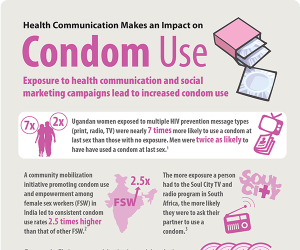HIV Evidence Package Proves the Power of Health Communication
 The Health Communication Capacity Collaborative (HC3) has collected a package of evidence showing the impact social and behavior change communication (SBCC) has on a number of HIV prevention and treatment areas, including condom use, voluntary medical male circumcision (VMMC) and the HIV continuum of care.
The Health Communication Capacity Collaborative (HC3) has collected a package of evidence showing the impact social and behavior change communication (SBCC) has on a number of HIV prevention and treatment areas, including condom use, voluntary medical male circumcision (VMMC) and the HIV continuum of care.
The package consists of a searchable evidence database, fact sheets and a series of infographics highlighting key articles.
SBCC, also referred to as health communication, around HIV and AIDS can influence factors related to HIV behaviors in a positive direction. These factors include knowledge and attitudes about testing, perceived risk of HIV infection, self-efficacy to protect oneself from HIV, emotional reactions such as fear of transmitting HIV to an unborn child, and perceived social and gender norms around testing, among others. Understanding behavioral drivers related to HIV helps influence them and better appreciate the complexities underpinning human decision-making.
Research consistently shows evidence-based communication programs can increase knowledge, shift attitudes and cultural/gender norms, and produce changes in a wide variety of HIV-related behaviors.
Even though communication interventions alone cannot overcome the challenges of HIV and AIDS in the absence of high-quality prevention and care services, biomedical interventions also need communication support to succeed. For example, SBCC can improve the quality of services and counseling, publicize and explain these services, while also improving provider–client interactions.
HC3 has collected the evidence of SBCC’s impact in an online database that can be searched by keyword, author, country, study design or communication intervention. The database is also searchable by the following HIV prevention and treatment areas:
- HIV Testing and Counseling (HTC)
- VMMC
- Prevention of Mother to Child Transmission (PMTCT)
- Treatment Continuum
- Condom Use
- Other Prevention
HC3 then ranked the evidence collected and created fact sheets of the evidence through a color-coding system. Non-peer-reviewed articles were ranked the lowest, with those demonstrating intention for a key behavior (i.e. intention to use condoms) ranked next. Those peer-reviewed articles that report on actual behavior change outcomes were ranked highest.
In addition to the database, HC3 has developed a series of infographics to highlight key evidence from the collection in a visually appealing format. Infographics are available for:
HC3 will continue to update and refine the HIV evidence package as new articles become available. If you have anything to add to the collection, please submit it to info@healthcommcapacity.org for consideration.








Leave a Reply
Want to join the discussion?Feel free to contribute!